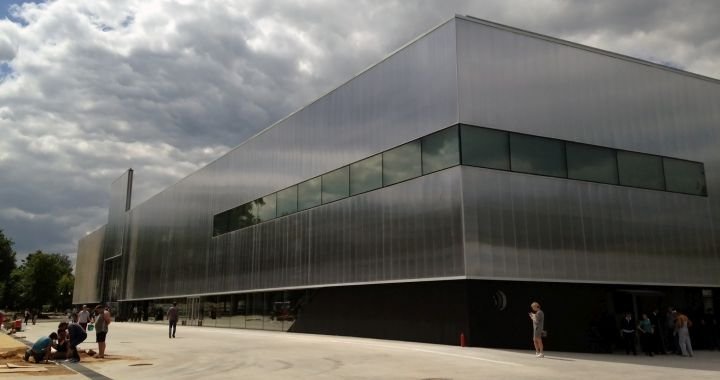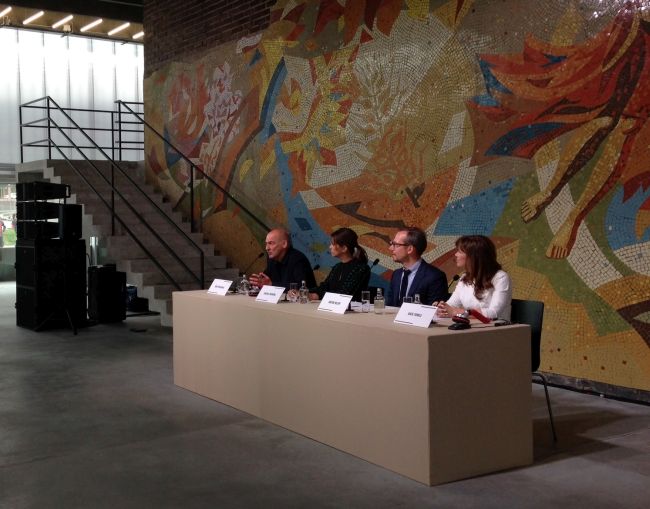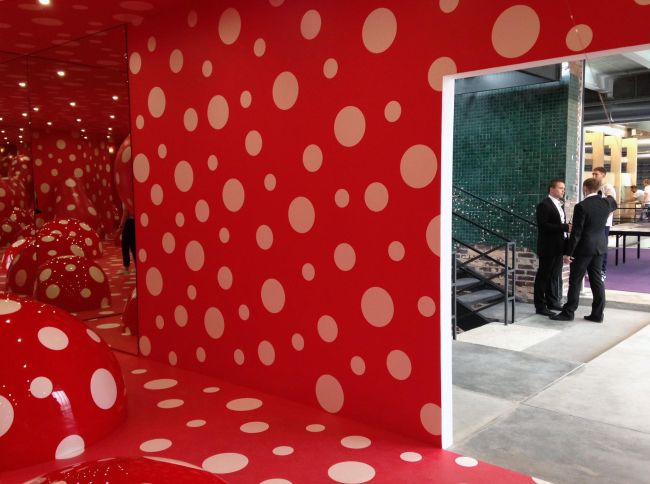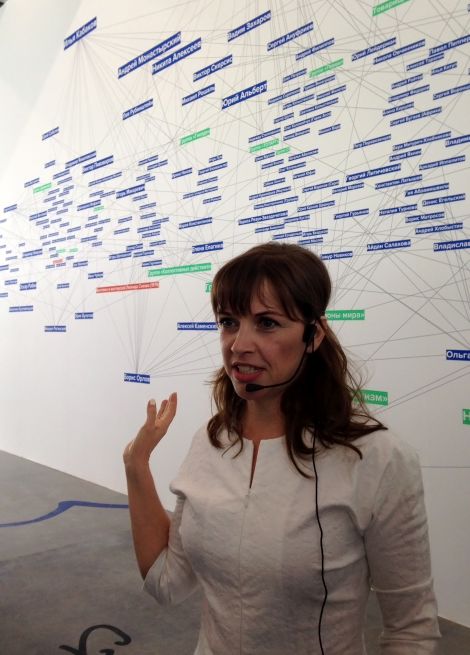
Tomorrow Is The Question
Lisa Borovikova
14/06/2015
Photo: Lisa Borovikova
The new building for the Museum of Contemporary Art called “Garage” has just opened in Moscow on 10 June together with a plethora of exhibitions. Its setup was entrusted to Rem Koolhaas’s team.
The view that opens up before the first visitors to the new building of the Garage Museum of Contemporary Art is impressive. Although the finishing touches of the adjacent territory are not yet done, and the workers are hurrying to polish the tarmac in front of the entrance for the upcoming opening, the image of the new “Garage” looks complete. The architects managed to create a memorable image with this huge metallic luster building that catches the eye, which is unlike anything done before, even though the basis for their work was the standard catering building that was built in 1968.
The construction of the new museum was commissioned to the architectural bureau OMA and its founder Rem Koolhaas. The work began in March 2011, and at that time the former building of the “Seasons of the Year” restaurant was only planned to be temporary. The main pavilion was to be the “HEX”, designed by I.V. Zholtovsky. The construction began with the “Seasons of the Year” restaurant building, which was scheduled to be finished in just one year, but the process of preparation for the implementation of the project proved to be very difficult (Koolhaas admits that it was the paperwork and the red tape that turned out to be the hardest part of the whole process). The decision was made to preserve the “HEX” and to equip the former restaurant as the main building of the museum.

Rem Koolhaas speaks at a press conference. On the background - “Autumn”
The outside of the building looks ultra-contemporary, but as you step inside the main area of the ground floor of the museum, you immediately spot the familiar interior details of a Soviet public building of the 1960s: the typical mosaic with allegorical subjects (in this case it is “Autumn”), green tiles on the walls, and red bricks that are sometimes peeking out from under the tiles. For Koolhaas it was important to place everything necessary for the museum without changing the existing structure. That included the bright orange zone of the cloakroom which fits harmoniously into the interior, and the bookshop and the buffet look as if they remained the same since the time of their first construction.
The architects did not set out to restore the “Seasons of the Year” restaurant, instead they sought to emphasize that its existence as a catering institution was left in the past and now the building had a new life. “The ‘Winery’ was built to produce alcoholic beverages, but today no one considers it from the standpoint of the history of alcohol production. This building is a former restaurant, but we wanted it to be associated with the political and social context that existed in the period of its creation,” Koolhaas stated.

The architect knows about this context firsthand, because in 1965, when the “Seasons of the Year” had not yet been built, he came to the Soviet Union as a journalist. In the Museum of Architecture in Moscow he saw drawings by I.I. Leonidov, which, according to Koolhaas, greatly influenced his decision to change his profession. “Leonidov used architecture not to create external effects, but to organize life in a new way,” says Koolhaas. “He designed separate ‘episodes’, and then put them together into a coherent story.” The “Garage” building was decorated by the same principle; it had a lot of small areas which were inextricably linked to the main space of the museum. This huge space, the “generosity” of Soviet architecture was the highlight that the architects wanted to emphasize.
The dimensions of the building allowed the “Garage” to significantly increase the number of its exhibition areas: a temporary pavilion that was built by Shigeru Ban in 2012 is 2000 m² in size, and the “Seasons of the Year” building covers an area of 5500 m².
It would be a shame to leave this space empty, so the “Garage” is already hosting a range of projects which will reflect the work of this institution from different angles.
The first installation can be seen from the street. It is a huge poster by E. Bulatov with the large-scale slogan “Come to ‘Garage’!” and it can be seen through the glass wall of the building. This is the first artwork in the framework of the project “Garage Atrium Commissions” which demonstrates the capabilities of the new building. The artist is offered a space with the height of 9.5 meters and the width of 11 meters, for which he needs to create one copy of a unique work of art. The installation can be seen from both outside and inside the museum, and furthermore it is seen from every floor.
The remaining exhibition space was given by the organizers to world-class artists to create their projects, and those were Yayoi Kusama and Rirkrit Tiravanija.

Rirkrit Tiravanija's exhibition “Tomorrow Is The Question”. Visitors here can play ping-pong
The Argentinian artist Tiravanija, described as a “happy Thai man who cooks”, became famous for his performances that push the viewer to interact with the author and the space of the museum. His project in the “Garage” called “Tomorrow Is The Question” is a kind of dialogue with the Czechoslovak artist Július Koller (1939 - 2007). The photo documentation of the latter’s projects, as well as his work titled “Ping-Pong Monument (U.F.O.)” (1971), are presented in a separate section of the exhibition. Tiravanija did not limit himself to just the monument; during the exhibition each visitor can play ping-pong on one of the many tables, then record the results of the game on special slates on the walls. The artist also used his trademark method of preparing and consuming food right in the museum: near the gaming tables there are two “stations” where the visitors can make pelmeni (Russian dumplings that reference the building’s origins as a restaurant). The project continues outside the “Garage”, as the viewer can order and pick up a t-shirt with one of the slogans coined by the artist: “Tomorrow Is The Question”, “What else”, “Do you feel the same as I do”, etc.

Rirkrit Tiravanija's “T-shirt Factory”
Rirkrit Tiravanija talked exclusively to Arterritory about his project: “I came here for research a little bit. I kind of knew the space, I had seen it from the presentation that Kate gave me, I had been working on this project for a while. I started to look around and I tried to bring different pieces together. And I think that the works of Julius Koller kind of triggered the exhibition. The most inspiring thing was that I found a ping pong club that was already working in the Gorky park, it is very unusual to put tables outside, this could create a good situation for public to enter. I wanted to involve the public into the building by this activity. The building was a restaurant, so I looked at their menu to find ideas for food when we had our research.
This space is only at the beginning, I think if you look at different exhibitions you will see. I think they have very diverse ideas, they have a lot of possibilities to present a lot of ideas and I appreciate this. But of course time will show.”

Yayoi Kusama's installation
Although Tiravanija created a project specifically for the new “Garage” building, Yayoi Kusama, an 86-year-old artist from Japan, provided her already proven work. Two installation are presented as part of her exhibition “Infinity Theory” on the third floor of the museum, “Infinity Mirrored Room – The Souls of Millions of Light Years Away” (2013) and “Guidepost to the Eternal Space” (2015). The latter was executed in 2015, but it pursues the theme of “dots” with which the artist has become world famous. These works look particularly impressive in the interior of the museum. You suddenly find yourself in a world of abstract and chaotic hallucinations of the artist among the well-organized building of the modern age. There is another installation by Kusama outside the museum called “Ascension of Polkadots on the Trees”, already implemented in many cities around the world. The artist’s team wrapped the trees in red cloth decorated with white polka dots, spreading the artist’s passion for dots distributed in an open space. This time Kusama had faced unexpected difficulties, “The team had never faced such difficult trees as they have in Russia,” Kate Fowl, the chief curator of “Garage”, laughed.

“Face-to-Face: The American National Exhibition in Moscow, 1959/2015” by Тhe Museum of American Art in Berlin
The main task of the curators was to highlight all aspects of life for the centre of contemporary culture, which is what the “Garage” is. This meant not only the organization of exhibitions of famous artists, but also the demonstration of the archive and the research department. Most of these projects are now located on the second floor of the museum. Here you can see an exhibition of photographs by Georgy Kiesewalter called “Insider”, which reflects the artistic life in the Soviet Union of the 1970s-80s. Also, the “Garage” presented its program “Field Research” on a large scale, which was founded in 2013. Now we can see the results of four of those projects. The project “Saving Bruce Lee: African and Arab Cinema in the Era of Soviet Cultural Diplomacy (A Prologue)” is dedicated to the fate of the African and Arab filmmakers who studied in the USSR. The installation “Black Square XVII” by Taryn Simon is situated outside the museum for the moment, as the project had used radioactive waste materials and the curators are waiting for the moment when the object will be safe for the public. In the cinema you can watch the film “This is Cosmos” by Anton Vidokle, dedicated to Russian cosmism. Finally, the fourth project “Face-to-Face: The American National Exhibition in Moscow, 1959/2015” by Тhe Museum of American Art in Berlin, is dedicated to the interaction between the USSR and the United States during the Cold War, and the exhibition demonstrates the differences and similarities between the two superpowers. Like Rirkrit Tiravanija’s exhibition, this project allows the viewer to interact with the museum’s space using interactive exhibits.
The “Garage” has also launched its educational program “Garage’s Teens Team”. Thirty participants developed and implemented the project “The Sixties: Point of Intersection”. The young curators selected six typical characters from the 1960s (nonconformist, student, worker, woman, scientist) and invited the audience to find the common features of these people. To do this, the project provided an interactive program: the object of the “scientist” is equipped with personal dossiers of the USSR scientists, some of whom are actual relatives of the curators, the “Worker” object invites the viewer to go through a text quest and to try on the role of the Soviet proletariat.

The research project called “The Family Tree of Russian Contemporary Art” is the largest installation on the ground floor of the “Garage”. The names of Russian artists and titles of artistic groups are marked on a huge white cloth, all of them connected by lines that demonstrate the relationship between these characters. “We're trying to date the different events and show how they are all connected. The project is not complete, it is a kind of invitation for cooperation. Our research requires the participation of many people, we want that the understanding of the history of unofficial Russian art would be formed through dialogue, through people sharing their stories that we would gather altogether,” says Kate Fowl about the project.

Kate Fowl tells about “The Family Tree of Russian Contemporary Art”
The new building of the “Garage” is impressive, its architectural solution is unique, and the building without the art already by itself looks interesting and unusual. But therein lies the challenge for the curators. Before the opening they had enough time to prepare high-quality exhibitions of world-renown artists and to adequately represent the extensive research activities of the museum. Will they be able to continue to support this level of quality that is defined by the exhibition space itself? Tomorrow is the question.